6 Most Stunning and Beautiful Churches In The World
The architecture of cathedrals and great churches is characterized by the buildings' large scale and follows one of several branching traditions of form, function, and style that derive ultimately from the Early Christian architectural traditions established in Late Antiquity during the Christianization of the Roman Empire.
Nowadays, these gorgeous and ancient churches have become the most beautiful tourist attraction around the world, and worshippers visit them every year.
1. Saint Basil's Cathedral, Russia
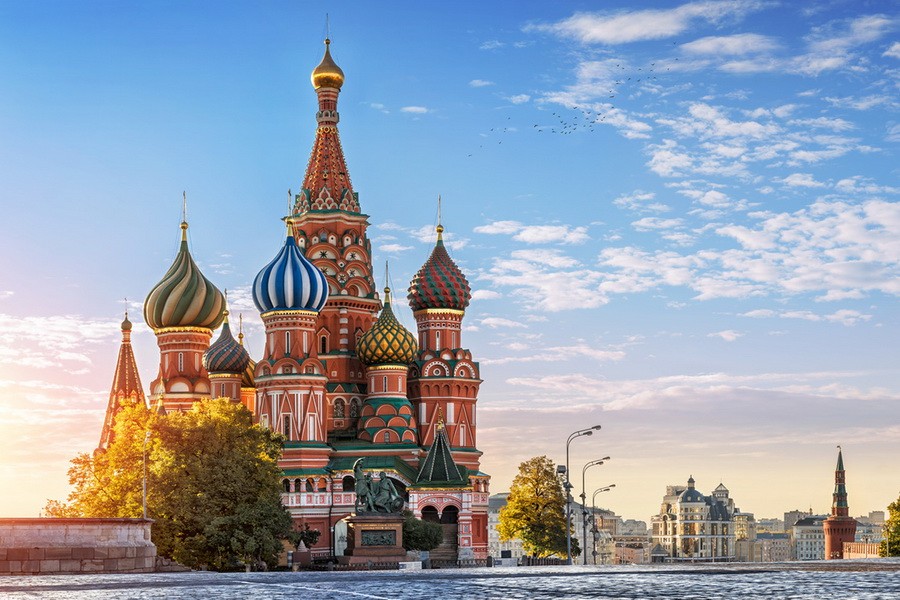 |
| Photo: Advantour |
The Cathedral of Vasily the Blessed (Russian: Собо́р Васи́лия Блаже́нного, tr. Sobór Vasíliya Blazhénnogo), commonly known as Saint Basil's Cathedral, is an Orthodox church in Red Square of Moscow and is one of the most popular cultural symbols of Russia. The building, now a museum, is officially known as the Cathedral of the Intercession of the Most Holy Theotokos on the Moat, or Pokrovsky Cathedral. It was built from 1555 to 1561 on orders from Ivan the Terrible and commemorates the capture of Kazan and Astrakhan. It was the city's tallest building until the completion of the Ivan the Great Bell Tower in 1600.
The original building, known as Trinity Church and later Trinity Cathedral, contained eight chapels arranged around a ninth, central chapel dedicated to the Intercession; a tenth chapel was erected in 1588 over the grave of the venerated local saint Vasily (Basil). In the 16th and 17th centuries, the church, perceived (as with all churches in Byzantine Christianity) as the earthly symbol of the Heavenly City, was popularly known as the "Jerusalem" and served as an allegory of the Jerusalem Temple in the annual Palm Sunday parade attended by the Patriarch of Moscow and the Tsar.
The cathedral has nine domes (each one corresponding to a different church) and is shaped like the flame of a bonfire rising into the sky, a design that has no parallel in Russian architecture. Dmitry Shvidkovsky, in his book Russian Architecture and the West, states that "it is like no other Russian building. Nothing similar can be found in the entire millennium of Byzantine tradition from the fifth to the fifteenth century ... a strangeness that astonishes by its unexpectedness, complexity and dazzling interleaving of the manifold details of its design." The cathedral foreshadowed the climax of Russian national architecture in the 17th century.
2. Gergeti Trinity Church, Georgia
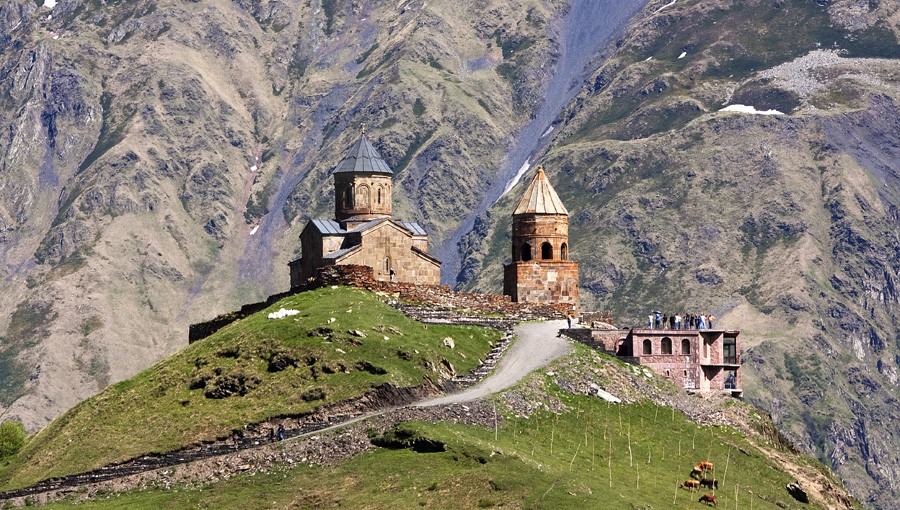 |
| Photo: Wikipedia |
The Gergeti Trinity Church is said to be one of the most beautiful and remarkable churches in the world. It is located on top of a mountain near Stepantsminda (Kazbegi) at an elevation of 2,170 meters above sea level.
Built in the 14th century, the Gergeti Trinity Church in the Greater Caucasus mountains has become the poster child for Georgian tourism. It is the only cross-cupola church in Khevi province. Surrounded by high mountains and the vastness of nature, it has become a national symbol of Georgia.
The church has been restored several times. The last restoration (author of the project R. Gverdtsiteli) was held in 1970-74. Parts of the roof and laggard, the neck of the dome, have been restored. Gergeti Trinity Church with a central dome is built of hewn stone. The inside of the dome is made entirely of brick. Entrance from the west and south. To the south of the temple, ten meters away, stands a two-story bell tower built in the second half of the 14th century. The first floor of the bell tower was the entrance to the fence. There are small windows on the east and west walls, according to My Caucasus.
3. Notre-Dame de Paris
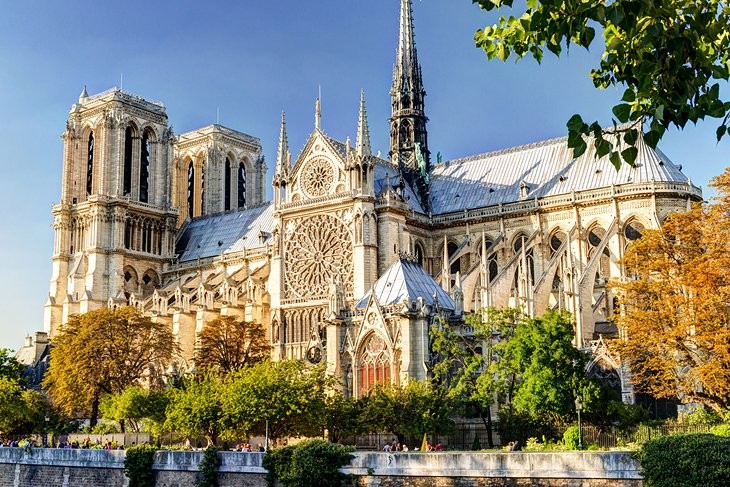 |
| Photo: Cultural Heritage Online |
Notre-Dame de Paris referred to simply as Notre-Dame, is a medieval Catholic cathedral on the Île de la Cité in the 4th arrondissement of Paris. The cathedral was consecrated to the Virgin Mary and is considered to be one of the finest examples of French Gothic architecture. Its pioneering use of the rib vault and flying buttress, its enormous and colorful rose windows, as well as the naturalism and abundance of its sculptural decoration set it apart from the earlier Romanesque style. Major musical components that make Notre Dame stand out include its three pipe organs, one of which is historic; and its immense church bells.
The cathedral's construction began in 1163 under Bishop Maurice de Sully and was largely complete by 1260, though it was modified frequently in the following centuries. In the 1790s, Notre-Dame suffered desecration during the French Revolution; much of its religious imagery was damaged or destroyed. In the 19th century, the cathedral was the site of the coronation of Napoleon I and the funerals of many presidents of the French Republic.
The cathedral is one of the most widely recognized symbols of the city of Paris and the French nation. As the cathedral of the Archdiocese of Paris, Notre-Dame contains the cathedra of the archbishop of Paris (Michel Aupetit). In 1805, Notre-Dame was given the honorary status of a minor basilica. Approximately 12 million people visit Notre-Dame annually, making it the most visited monument in Paris. The cathedral was renowned for its Lent sermons, founded by the Dominican Jean-Baptiste Henri Lacordaire in the 1830s. In recent years, an increasing number have been given by leading public figures and state-employed academics.
4. Hallgrímskirkja, Reykjavík, Iceland
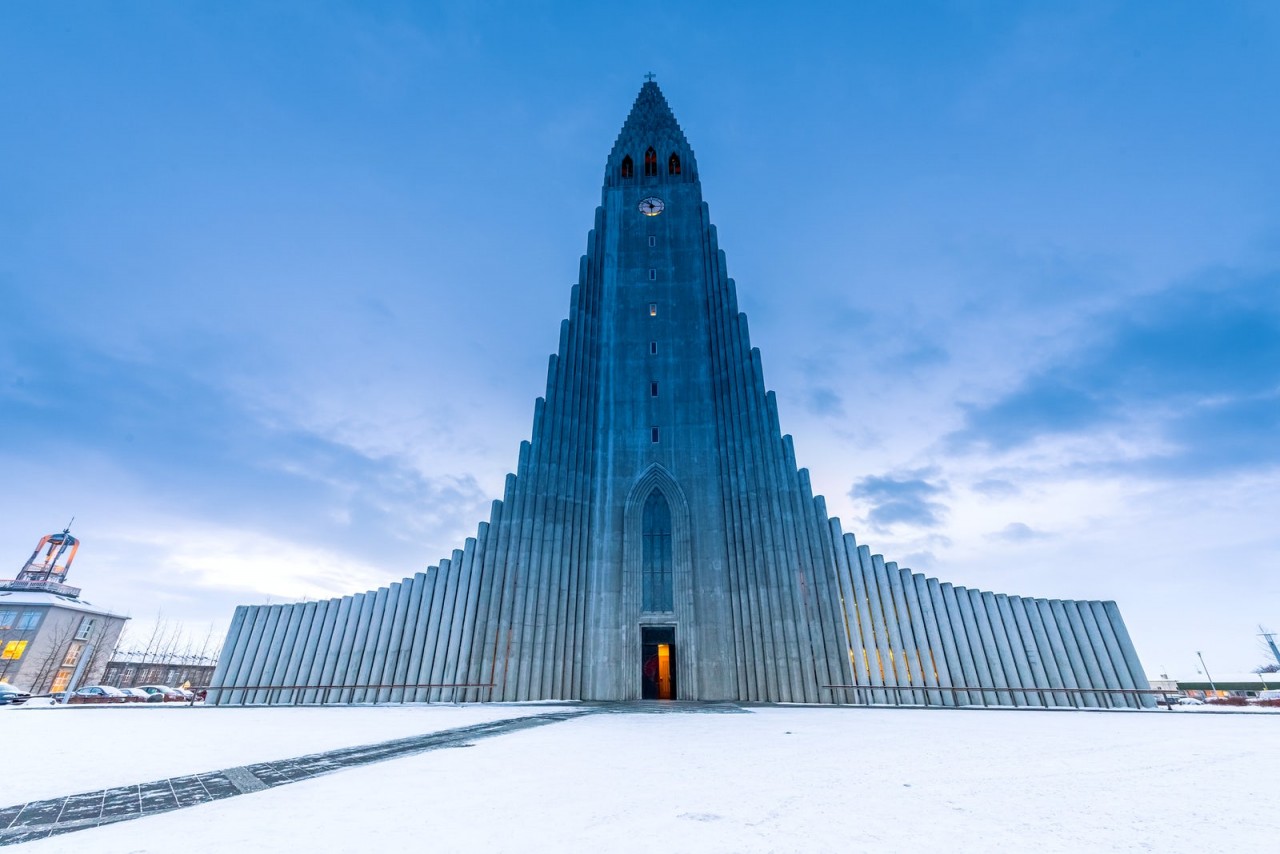 |
| Photo: Itinari.com |
Visible from almost any point in the city, Hallgrimskirkja Church sits at the top of Skolavordustigur Street, the central art and design shopping street in the capital. The iconic building is 74,5 meters (240 ft) high, and a visit to the top will reward you with awe-inspiring views of Reykjavik and even Snaefellsjokull glacier on a clear day. For a modest fee, visitors can enter the church tower and enjoy the majestic view.
Completed in 1986, the concrete structure took over 40 years to build. The tower was renovated in 2009. The soaring modernist church was designed to resemble the basalt lava flows found in Iceland‘s natural landscape, especially the basalt columns around Svartifoss waterfall.
Named after 17th-century hymn writer Hallgrimur Petursson, Hallgrimskirkja is a Lutheran church, as are most churches in Iceland. Services are held each Sunday. The wonderful acoustics and the enormous pipe organ make it an ideal venue for classical music concerts, according to Iceland Travel.
5. Notre-Dame Cathedral Basilica of Saigon, Vietnam
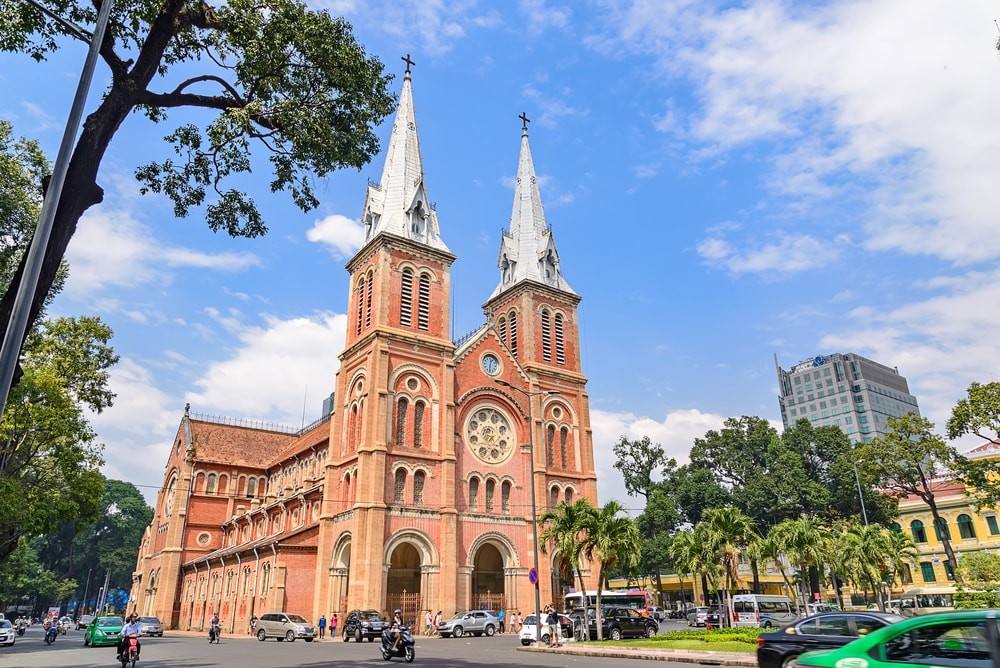 |
| Photo: Shutterstock |
Notre-Dame Cathedral Basilica of Saigon has gone by various names over the years. It began life in 1863 as Saigon Church, built by French colonists shortly after France conquered and began to colonize Saigon. Saigon Church was a simple wooden construction with a bad case of termites, which caused so much damage it had to be rebuilt.
A design competition was held, which was won by French architect Jules Bourard, an expert in religious architecture. His plan was about as French as it gets: to build a smaller version of Notre-Dame de Paris, mirroring the famous cathedral’s form in the Romanesque and French Gothic style.
Bishop Isidore Colombert laid the first stone in October 1877, and the completion ceremony was held in April 1880. Most of the materials used in the cathedral’s construction had been shipped over from France, including bricks from Toulouse that gave the cathedral its distinct red color, as still seen today. Two bell towers were added in 1895, breaking with the design of Notre-Dame de Paris but adding greatly to the dramatic impact and the height of the cathedral, which now reached up to an impressive 198 feet tall.
In 1959, a statue of Our Lady of Peace was installed outside the church, made with granite in Rome. After the statue ceremony, Saigon Church became more commonly known as Notre-Dame Cathedral. In 1960 it earned the official title of Saigon Chief Cathedral, and two years later was anointed by Pope John XXIII, gaining basilica status and earning its current title of Notre-Dame Cathedral Basilica of Saigon, according to Atlas Obscura.
6. Duomo di Milano, Italy
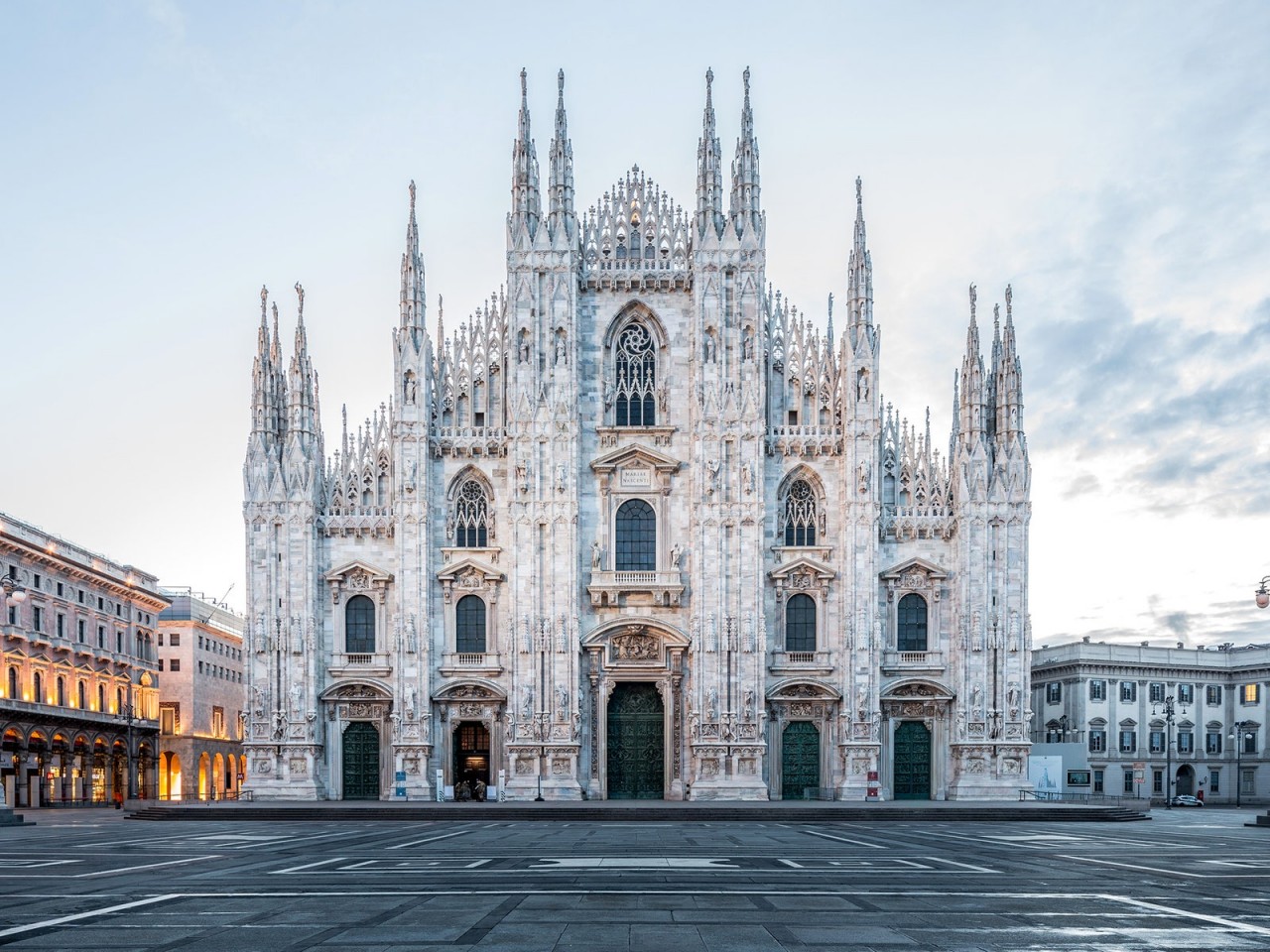 |
| Photo: Getty Images |
The Duomo, the Cathedral at the heart of the city, is an architectural masterpiece that remains imprinted in the memory of all those who visit Milano. The thousands of intricately carved spires and statues, like a marble forest, are an awesome sight for those exiting the Metro or arriving from Galleria Vittorio Emanuele. It is not surprising to learn that its construction, which began in 1386 and lasted almost half a millennium, was commissioned by the Duke of Milano Gian Galeazzo Visconti as a symbol of the glory and grandeur of the city.
Milano’s Duomo is the largest and most elaborate Gothic building in Italy: made of pink-hued white marble from a dedicated quarry, it is 157 meters in length and 108.5 meters high at the top of the main spire, where rests the glistening golden statue of the Madonnina, an evocative symbol much-loved both by all Milanese and visitors. It is not generally known that there are quite a few copies of Milano’s Madonnina around the world, including one on Mount Everest.
The Duomo is also the largest Gothic building in the world whose rooftop you can actually walk on. A visit up to the terraces is highly recommended to admire the unmissable panorama of the city and the mountains in the distance, according to Yes Milano.
 | Top 7 Tallest And Biggest Statues In The World Building statues is hard work, and some of the biggest and tallest statues in the world nowadays are considered masterpieces for their incredible architecture and ... |
 | Irohazaka: The Most Beautiful Must-Visit Winding Road In The Autumn Japan is a perfect destination for an autumn trip, with many beautiful and interesting spots to see, including Irohazaka road, which transforms into a gorgeous ... |
 | The Shortest Rivers In The World That You Probably Havent Heard Of There are the longest and biggest rivers in the world, and there are also the ones that are considered the shortest by World Records, which ... |
Recommended
 World
World
Pakistan NCRC report explores emerging child rights issues
 World
World
"India has right to defend herself against terror," says German Foreign Minister, endorses Op Sindoor
 World
World
‘We stand with India’: Japan, UAE back New Delhi over its global outreach against terror
 World
World
'Action Was Entirely Justifiable': Former US NSA John Bolton Backs India's Right After Pahalgam Attack
 World
World
US, China Conclude Trade Talks with Positive Outcome
 World
World
Nifty, Sensex jumped more than 2% in opening as India-Pakistan tensions ease
 World
World
Easing of US-China Tariffs: Markets React Positively, Experts Remain Cautious
 World
World


